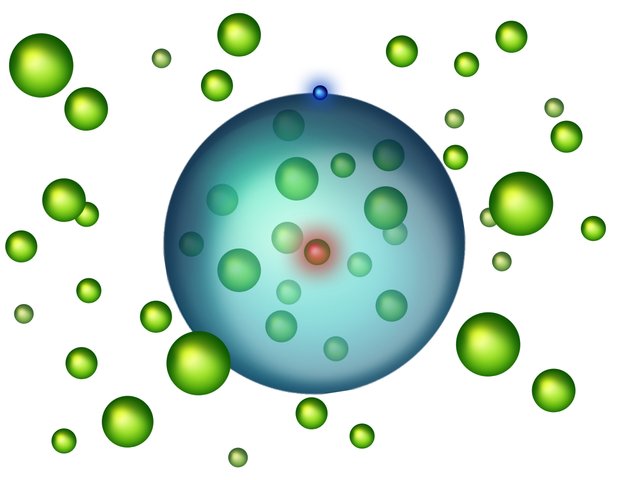A "GIANT ATOM" That "Devours" Other Atoms...... Rydberg Polarons... Exciting Form of Matter....
Scientists Create A "Giant Atom" That "Devours" Other Atoms.... Rydberg Polarons

Image Credit :- Phys.org
Scientists from the University of Stuttgart have created a new State of Matter, which is basically a Pseudo Atom that is Microns in size, filled with other atoms. This atom has thousands of "normal atoms" in its electron orbital, it's like eating the Quantum Gas of the Bose-Einstein Condensate.
If you don't know what a Bose-Einstein Condensate is, then I suggest to read this article quickly, it will help to understand this article:- Bose-Einstein Condensate

The Concept

Image Credit: Source
In the field of Atomic Physics we talk about something called the Rydberg Atom, it's an atom where a single electron with high energy is excited to higher energetic levels, where it orbits its nucleus at large distances.
“The average distance between the electron and its nucleus can be as large as several hundred nanometres - that is more than a thousand times the radius of a hydrogen atom,” said Professor Joachim Burgdörfer of Vienna University in a statement.
Reference
Scientists decided to combine the theory Bose-Einstein condensates with Rydberg atoms. A Bose-Einstein condensate consisting of strontium atoms was created, then a laser was used to excite one of the BEC atoms and create a Rydberg atom. The result was the production of an electron that orbits around itself and 100's of other strontium atoms that was engulfed by the excited electron.
“The atoms do not carry any electric charge, therefore they only exert a minimal force on the electron,” said Shuhei Yoshida.
Reference
Small perturbations of the potential from the neutral atoms engulfed by the giant atom can scatter electrons slightly without destroying the orbit. This weakly interacting system decreases the total energy of the system, which allows for bonding between the GIANT Rydberg atom and the trapped inner atoms.
Understand that this is not the unusual situation, usually we consider charged nuclei, that bind to the electrons around them. But here, the electron binds to neutral atoms. This system holds only when the temperatures are close to absolute zero and the bosons exist in thier lowest energy state. If the temperature is increased beyond the critical temperature of the BEC then the particles have higher energy and the bond breaks, which destroys the Rydbreg Polaron.
“For us, this new, weakly bound state of matter is an exciting new possibility of investigating the physics of ultracold atoms,” said Burgdörfer. “That way one can probe the properties of a Bose-Einstein condensate on very small scales with very high precision.”
Reference

Image Credit:-tuwien.ac.at

The basic idea now is simple: Instead of using a technically challenging electron trap, the scientists are using the fact that in nature electrons are bound to a positively charged atomic core. In a classical picture, they are travelling on ellipsoidal orbits around the core. These orbits are usually very small, typically in the range below one nanometer. In order to achieve an interaction between an electron and many atoms, an atom is excited from a cloud consisting of 100.000 atoms using laser light. The orbit of a single electron then expands to several micrometers and a Rydberg atom is formed. On atomic length scales, this atom is huge, larger than most bacteria, which are consisting each of several billions to trillions of atoms. The Rydberg atom is then containing tens of thousands of atoms from the cold cloud. Thus, a situation is realized where the electron is trapped in a defined volume and at the same time interacts with a large number of atoms. This interaction is so strong that the whole atomic cloud, consisting of 100,000 atoms is considerably influenced by the single electron. Depending on its quantum state the electron excites phonons in the atomic cloud, which can be measured as collective oscillations of the whole cloud culminating in a loss of atoms from the trap.
Reference: phys.org

Possible Benefits
After studying the field of Condensed Matter Physics, this strikes me as ground breaking. I have just learnt about this today, I am very very excited to see where it can take us. At first thought this system could lead the way to understanding further super conductors. Maybe this can lead us to producing super conductors at room temperatures, break throughs like this are amazing. Bare in mind this is something that comes to mind and may not be fact. However, in the coming days I will study this further and write another post on my discoveries. For now this is just an introduction to the topic. This field of study is heavy but very rewarding, I will update in the coming days.
I am very excited!!

If this post interested you then you can find the research paper here:- Coupling a single electron to a Bose–Einstein condensate, at Nature.com
Feel free to UPVOTE, FOLLOW, and RESTEEM.
References are contained throughout the article

I love 'updates' like this, they save me time for searching for breakthroughs :)
Keep it up :)
Thanks @mrlogic, I appreciate your comment, and upvote of course.
I had an update on my phone this morning, I had a read and was really really happy to see it.
I have a few things i must do atm, but in the next days i'll be studying the topic and posting further.
Feel free to follow. I do keep up to date with the world of Physics.
Have a good day :)
Thanks for upvoting, upvoting you!